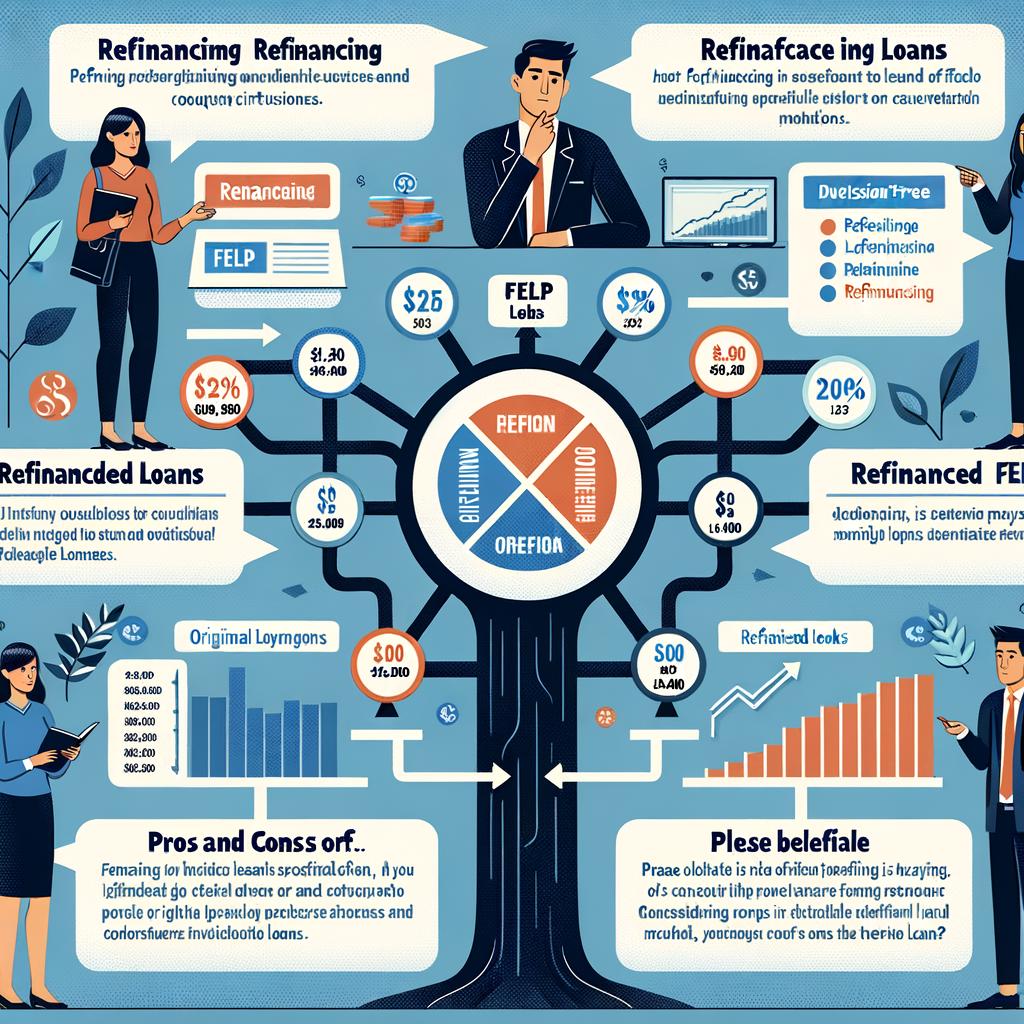Nestled within the labyrinth of student financial assistance is a relic not many today might recognize: the Federal Family Education Loan Program (FFELP). Established in 1965, this government initiative once danced at the forefront of higher education funding, intertwining federal resources with private lenders to weave a tapestry of opportunity for generations of students. Picture this: a historical mosaic of ambition, where aspiring scholars could tap into a well of resources to fuel their educational pursuits. Although its heartbeat ceased in 2010, replaced by the Direct Loan Program, the echoes of FFELP still ripple through the financial tranquility of many today. Are you one of the countless borrowers navigating the remnants of this bygone but not forgotten program? Journey with us through the corridors of time as we unravel the complexities and guide you through understanding the FFELP loans, offering essential wisdom to manage this artifact of educational history effectively.
Table of Contents
- Understanding FFELP Loans: Origins and Basic Mechanics
- Navigating Repayment Options and Strategies for FFELP Borrowers
- Refinancing or Consolidating FFELP Loans: Is It the Right Move for You?
- The Future of FFelP Loans: Staying Informed About Legislative Changes
- The Way Forward

Understanding FFELP Loans: Origins and Basic Mechanics
The Federal Family Education Loan Program (FFELP) was a cornerstone in American higher education finance for many years before being phased out. Instituted by the Higher Education Act of 1965, FFELP represented a public-private partnership where private lenders provided federally backed student loans. Understanding how this program worked provides valuable insights into the evolution of student financial aid systems in the U.S.
FFELP loans were unique in their structure and operation. Unlike Direct Loans—funded directly by the federal government—FFELP loans involved third-party lenders like banks or credit unions. The federal government guaranteed these loans, which shielded lenders from the risk of borrower default. This system was intended to boost lenders’ willingness to participate, thereby increasing the availability of student loans.
The basic mechanics began with a student applying for a loan through a private lender. Once the loan was granted, it was guaranteed by one of several federally approved guaranty agencies. To fund these loans, lenders often grouped and sold them as asset-backed securities to investors, a process that provided the lenders with the necessary capital to offer more loans.
Types of Loans Under FFELP:
- Stafford Loans (Subsidized and Unsubsidized)
- PLUS Loans for parents and graduate students
- Consolidation Loans
The subsidized Stafford Loans offered uniquely beneficial terms. For these loans, the U.S. Department of Education paid the interest while the student was in school or during other periods of authorized deferment. This feature made FFCLP loans especially attractive to students who needed to minimize their education costs.
The dynamics of the FFELP system also involved a repayment schema that extended up to ten years post-graduation, although terms could vary. Amidst evolving economic landscapes and burgeoning student debt crises, the FFELP faced criticism for its reliance on third-party lenders and the complexities of guarantee structures, leading to calls for reform.
| Loan Type | Interest Responsibility |
|---|---|
| Stafford Subsidized | Government pays while in school |
| Stafford Unsubsidized | Borrower pays during all periods |
| PLUS | Borrower pays during all periods |
In 2010, the FFEL program was effectively discontinued, replaced entirely by the William D. Ford Federal Direct Loan Program. The transition was driven by governmental efforts to streamline borrowing, minimize administrative costs, and reduce complexities. However, millions of borrowers are still paying off their FFELP loans, and understanding the intricacies of these legacy debts is crucial for effective financial planning.

Navigating Repayment Options and Strategies for FFELP Borrowers
If you’re grappling with Federal Family Education Loan Program (FFELP) repayments, understanding your options can significantly ease the burden. FFELP loans, once a cornerstone of federal student lending before the program ceased in 2010, still impact millions. Here, we delve into effective ways to manage these loans today.
Assessment and Evaluation: Begin by reviewing your existing loan details. Recognize your current balance, interest rate, and the servicer managing your loan. Ensuring you have all the correct and updated information will streamline the decision-making process.
Consolidation: One viable option for managing FFELP loans is consolidation through a Direct Consolidation Loan. This approach can potentially offer you access to additional repayment plans or forgiveness programs. For instance, consolidating your FFELP loan might make you eligible for programs like Income-Driven Repayment (IDR) plans or the Public Service Loan Forgiveness (PSLF) program.
In the table below, compare some of the repayment strategies that become available through consolidation:
| Repayment Strategy | Features | Eligibility |
|---|---|---|
| Standard Repayment | Fixed payments over 10 years | Direct Consolidation Loan holders |
| Graduated Repayment | Payments start low and increase over time | Direct Consolidation Loan holders |
| Income-Driven Repayment | Payments calculated based on income | Must apply and show proof of income |
Income-Driven Repayment Plans: If you face financial challenges, consider applying for an IDR plan. Although FFELP loans are not directly eligible, consolidating them into a Direct Loan can open this gateway. These plans adjust your monthly payments according to your income level and family size, potentially easing your financial commitment.
The list below outlines steps to apply for IDR plans:
- Consult with your loan servicer about your options
- Complete the IDR application through the official Federal Student Aid website
- Submit supporting documentation, like your tax returns or pay stubs
- Recertify your income and family size each year to maintain eligibility
Strategic Repayment: If consolidation or IDR plans do not align with your needs, perhaps a more tailored approach can work. This includes selecting a repayment plan that balances reasonable monthly payments with a strategic long-term total payment amount. Sometimes paying more than the minimum can significantly reduce the interest accrued over time.
Stay Informed: Laws and policies regarding federal student loans are subject to change. Keeping abreast of these developments can be crucial. For example, recent legislative changes have brought temporary expanded benefits for specific federal loan types due to global events like the COVID-19 pandemic.
Professional Guidance: Lastly, consider seeking advice from a financial advisor experienced with student loans. Professional guidance can offer personalized insights tailored to your specific financial scenario, helping decipher the complexities of FFELP loan payments and planning a path forward that considers your financial health and career objectives.

Refinancing or Consolidating FFELP Loans: Is It the Right Move for You?
If you’re grappling with the intricacies of Federal Family Education Loan Program (FFELP) loans, considering your options for refinancing or consolidating might be top of mind. Deciding whether to refinance or consolidate FFELP loans involves a deep dive into your personal financial scenario and an understanding of the potential benefits and drawbacks.
Understanding Refinancing
Refinancing FFELP loans means swapping your existing loans for a new one, typically with a lower interest rate and different terms. This move could help you save on interest and potentially reduce your monthly payments. However, it’s crucial to consider:
- The impact on interest rates: With a refinance, your new interest rate is dependent on your credit score and current market rates.
- Loss of federal loan benefits: If you refinance federal loans with a private lender, you’ll forfeit federal protections like deferment, forbearance, and access to income-driven repayment plans.
- Timing matters: If interest rates are notably lower than when you initially borrowed, refinancing might be especially beneficial.
Exploring Consolidation
For those looking to simply streamline their loan payments, consolidating your FFELP loans into a single Direct Consolidation Loan might be the answer. This option essentially combines multiple federal student loans into one, offering:
- Simplified payments: Instead of juggling multiple accounts and due dates, you’ll manage just one.
- Potential for lower payments: Consolidation can extend your repayment term, potentially leading to lower monthly payments.
- Retention of federal benefits: As consolidation does not involve moving to a private lender, you retain federal loan safeguards.
Evaluating Your Choices
Your decision to refinance or consolidate should align with your financial goals and career plans. Consider the following table to assist in making a balanced choice:
| Option | Key Benefit | Key Risk |
|---|---|---|
| Refinancing | Potentially lower interest rates | Lose federal loan protections |
| Consolidation | Streamlines payments, retains benefits | May result in higher total interest paid over time due to extended term |
Reviewing Your Financial Health
Before proceeding, evaluate your overall financial health. Key considerations include:
- Your credit score (particularly if considering refinancing).
- Your job security and income stability.
- Financial goals such as saving for a home or starting a business.
Seeking Advice
Seek advice from a financial advisor or a student loan counselor. It’s important to approach this with a complete understanding of your financial landscape and the long-term implications.
By carefully examining each route, you can decide if refinancing or consolidating your FFELP loans aligns with your current financial needs and future aspirations. Remember, while both options offer benefits, they also carry specific considerations that should be meticulously weighed.
The Future of FFelP Loans: Staying Informed About Legislative Changes
As you navigate the complexities of Federal Family Education Loan Program (FFELP) loans, you might be looking into what changes could occur in the future due to new legislation. Understanding potential legislative shifts is crucial for managing your existing loan effectively and planning for any financial adjustments.
Legislative changes can directly impact the terms, the availability of subsidies, or your repayment options. It’s vital to stay ahead of these changes to make informed decisions and possibly take advantage of favorable terms before they change. Here are several methodologies to keep yourself well-informed:
- Regularly visit the Federal Student Aid website: This is your primary resource for any official updates and comprehensive explanations of federal loan programs, including FFELP.
- Subscribe to education newsletters: Many online platforms offer newsletters that include updates on laws affecting student loans and education finance.
- Follow relevant social media feeds: Government and educational financial bodies often post updates on their social media channels.
Additionally, it’s beneficial to understand how past legislative changes have influenced FFELP loans, as they often set a precedent for future amendments. Here’s a glance at some significant legislative milestones that impacted FFELP:
| Year | Legislation | Impact |
|---|---|---|
| 2007 | College Cost Reduction and Access Act | Introduced income-based repayment plans. |
| 2010 | Health Care and Education Reconciliation Act | Ended new FFELP loans, shifting all new loans to the Direct Loan program. |
| 2021 | American Rescue Plan Act | Offered temporary tax-free status for student loan forgiveness. |
Another vital area is the relationship between state and federal legislation, as state laws can also influence the treatment of your loans. For instance, some states may offer additional deductions or subsidies for student loans. To track state-specific changes, consider the following:
- State Education Departments: These departments provide guidelines and announcements related to student loans within the state.
- Legal Advisors specializing in education law: Consulting with experts can provide insights tailored to your specific situation.
For those managing FFelP loans, proactive engagement with these resources is more than just a recommendation—it’s a necessity. As the legislative landscape evolves, often rapidly, staying informed can empower you to make strategic decisions about your education funding and debt management. Utilize these sources regularly and consider setting up alerts or bookmarks to ensure you receive the latest information as it becomes available.
Whether it’s keeping an eye on potential new benefits or preparing for changes in repayment conditions, your active participation in understanding and responding to legislative updates can make a significant difference in managing your FFelP loans effectively and sustainably.
The Way Forward
As the curtain falls on our exploration of the Federal Family Education Loan Program (FFELP), it’s clear that while this program has transitioned out, its echoes are still felt in the corridors of higher education financing. For those entangled within its legacy or merely curious about historical financial aid landscapes, understanding FFELP is akin to reading an old but significant chapter in the tale of educational funding.
In the world of student loans, knowledge truly is as potent as a full-ride scholarship. Whether you’re navigating current loans or consulting for future financial decisions, the labyrinth of terms, conditions, and eligibility criteria can be as complex as any college examination. We hope this guide serves as a trusty compass, helping you navigate through the remnants of FFELP or any similar financial ventures you encounter on your academic journey.
Stay empowered through learning; stay inspired through understanding. After all, every loan has its story, and every borrower, their unique path. Forge ahead with the wisdom of the past and the zeal for a future bright with possibility. As FFELP fades into the annals of history, your own story of educational achievement and financial savvy is just beginning to be written. Thank you for joining us through this exploration, and may your educational aspirations reach the heights they deserve.
